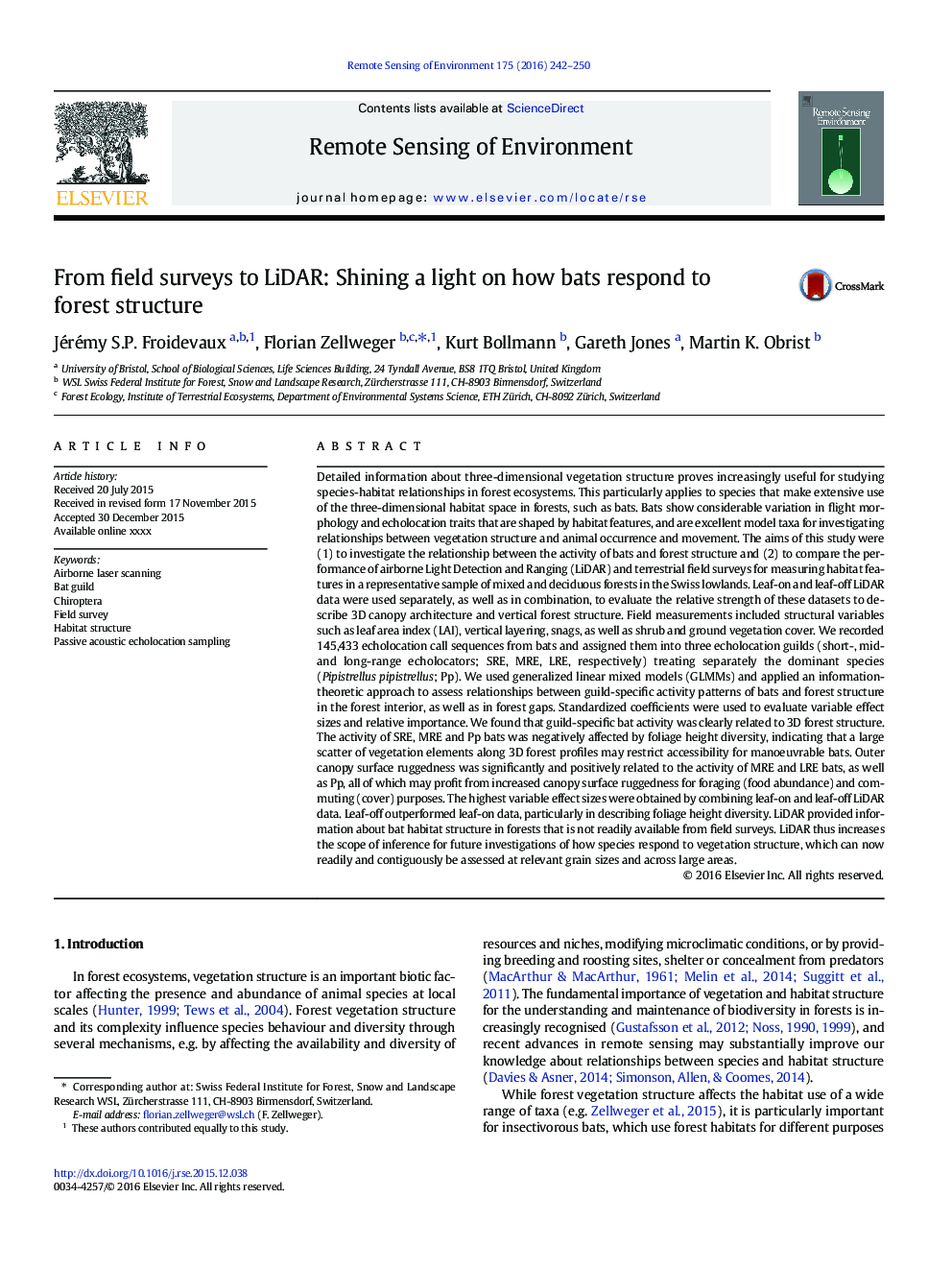| کد مقاله | کد نشریه | سال انتشار | مقاله انگلیسی | نسخه تمام متن |
|---|---|---|---|---|
| 6345626 | 1621225 | 2016 | 9 صفحه PDF | دانلود رایگان |
عنوان انگلیسی مقاله ISI
From field surveys to LiDAR: Shining a light on how bats respond to forest structure
دانلود مقاله + سفارش ترجمه
دانلود مقاله ISI انگلیسی
رایگان برای ایرانیان
کلمات کلیدی
موضوعات مرتبط
مهندسی و علوم پایه
علوم زمین و سیارات
کامپیوتر در علوم زمین
پیش نمایش صفحه اول مقاله

چکیده انگلیسی
Detailed information about three-dimensional vegetation structure proves increasingly useful for studying species-habitat relationships in forest ecosystems. This particularly applies to species that make extensive use of the three-dimensional habitat space in forests, such as bats. Bats show considerable variation in flight morphology and echolocation traits that are shaped by habitat features, and are excellent model taxa for investigating relationships between vegetation structure and animal occurrence and movement. The aims of this study were (1) to investigate the relationship between the activity of bats and forest structure and (2) to compare the performance of airborne Light Detection and Ranging (LiDAR) and terrestrial field surveys for measuring habitat features in a representative sample of mixed and deciduous forests in the Swiss lowlands. Leaf-on and leaf-off LiDAR data were used separately, as well as in combination, to evaluate the relative strength of these datasets to describe 3D canopy architecture and vertical forest structure. Field measurements included structural variables such as leaf area index (LAI), vertical layering, snags, as well as shrub and ground vegetation cover. We recorded 145,433 echolocation call sequences from bats and assigned them into three echolocation guilds (short-, mid- and long-range echolocators; SRE, MRE, LRE, respectively) treating separately the dominant species (Pipistrellus pipistrellus; Pp). We used generalized linear mixed models (GLMMs) and applied an information-theoretic approach to assess relationships between guild-specific activity patterns of bats and forest structure in the forest interior, as well as in forest gaps. Standardized coefficients were used to evaluate variable effect sizes and relative importance. We found that guild-specific bat activity was clearly related to 3D forest structure. The activity of SRE, MRE and Pp bats was negatively affected by foliage height diversity, indicating that a large scatter of vegetation elements along 3D forest profiles may restrict accessibility for manoeuvrable bats. Outer canopy surface ruggedness was significantly and positively related to the activity of MRE and LRE bats, as well as Pp, all of which may profit from increased canopy surface ruggedness for foraging (food abundance) and commuting (cover) purposes. The highest variable effect sizes were obtained by combining leaf-on and leaf-off LiDAR data. Leaf-off outperformed leaf-on data, particularly in describing foliage height diversity. LiDAR provided information about bat habitat structure in forests that is not readily available from field surveys. LiDAR thus increases the scope of inference for future investigations of how species respond to vegetation structure, which can now readily and contiguously be assessed at relevant grain sizes and across large areas.
ناشر
Database: Elsevier - ScienceDirect (ساینس دایرکت)
Journal: Remote Sensing of Environment - Volume 175, 15 March 2016, Pages 242-250
Journal: Remote Sensing of Environment - Volume 175, 15 March 2016, Pages 242-250
نویسندگان
Jérémy S.P. Froidevaux, Florian Zellweger, Kurt Bollmann, Gareth Jones, Martin K. Obrist,